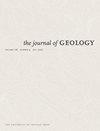New Zircon U-Pb Age and Its Restriction on the Warming Time of the Interglacial Paleoclimate during the Cryogenian in the Yangtze Block
IF 1.3
4区 地球科学
Q2 GEOLOGY
引用次数: 3
Abstract
The evolution of the paleoclimate and the duration of the two glacial periods during the Cryogenian in the Yangtze Block are of great geological significance for understanding “Snowball Earth.” We studied the evolution of the paleoclimate during the Cryogenian, using chemical weathering, and determined the warming time of the interglacial paleoclimate, using zircon U-Pb dating in the Yangtze region. A new laser ablation ICP-MS zircon U-Pb age of 659.9±3.2 Ma is reported from the middle Datangpo Formation. The chemical index of alteration (CIA) for the Cryogenian fine clastic rock samples from a drill core shows that the climate in the provenance area during the Gucheng and Nantuo glacial periods was dry and cold and that the chemical weathering was weak; the average CIA values were 63.3 and 64.2, respectively. In the early stage of the Datangpo period, the climate in the provenance area was still dry and cold, with a CIA average of 60.7, compatible with that in the two glacial periods; in the middle and late stages, the climate was warm and humid, chemical weathering was enhanced, and the average CIA rose to 77.4, compatible with the 76.9 of the Liantuo period before the Cryogenian. The evolution of other chemical weathering (paleoclimate) proxies, such as the chemical index of weathering, the plagioclase index of alteration, and Rb/Sr, is compatible with that of the CIA. The warming time of the interglacial paleoclimate during the Cryogenian in the Yangtze Block was ca. 660 Ma, roughly consistent with the ending time of the Sturtian in Australia and Mongolia, indicating that the lower part of the Datangpo Formation may still represent Sturtian glacial deposits, thus further suggesting the global consistency of the end of the Sturtian.新锆石U-Pb年龄及其对扬子地块低温期间冰期古气候变暖时间的限制
长江地块成冰纪古气候的演变和两个冰川期的持续时间对理解“雪球地球”具有重要的地质意义,利用长江地区锆石U-Pb测年。报道了一个新的激光烧蚀ICP-MS锆石U-Pb年龄为659.9±3.2Ma。钻孔岩芯中成冰纪细碎屑岩样品的化学蚀变指数(CIA)表明,故城、南陀冰川期物源区气候干燥寒冷,化学风化较弱;平均CIA值分别为63.3和64.2。在大塘坡期早期,物源区气候仍然干燥寒冷,CIA平均值为60.7,与两次冰川期相适应;中后期气候温暖湿润,化学风化作用增强,平均CIA上升到77.4,与成冰纪前连坨期的76.9一致。其他化学风化(古气候)指标的演变,如风化的化学指数、蚀变的斜长石指数和Rb/Sr,与CIA的演变是一致的。扬子地块成冰期间冰古气候的升温时间约为660 Ma,与澳大利亚和蒙古的斯图阶结束时间大致一致,表明大塘坡组下部可能仍代表斯图阶冰川沉积,从而进一步表明斯图阶末次的全球一致性。
本文章由计算机程序翻译,如有差异,请以英文原文为准。
求助全文
约1分钟内获得全文
求助全文
来源期刊

Journal of Geology
地学-地质学
CiteScore
3.50
自引率
5.60%
发文量
0
审稿时长
3 months
期刊介绍:
One of the oldest journals in geology, The Journal of Geology has since 1893 promoted the systematic philosophical and fundamental study of geology.
The Journal publishes original research across a broad range of subfields in geology, including geophysics, geochemistry, sedimentology, geomorphology, petrology, plate tectonics, volcanology, structural geology, mineralogy, and planetary sciences. Many of its articles have wide appeal for geologists, present research of topical relevance, and offer new geological insights through the application of innovative approaches and methods.
 求助内容:
求助内容: 应助结果提醒方式:
应助结果提醒方式:


